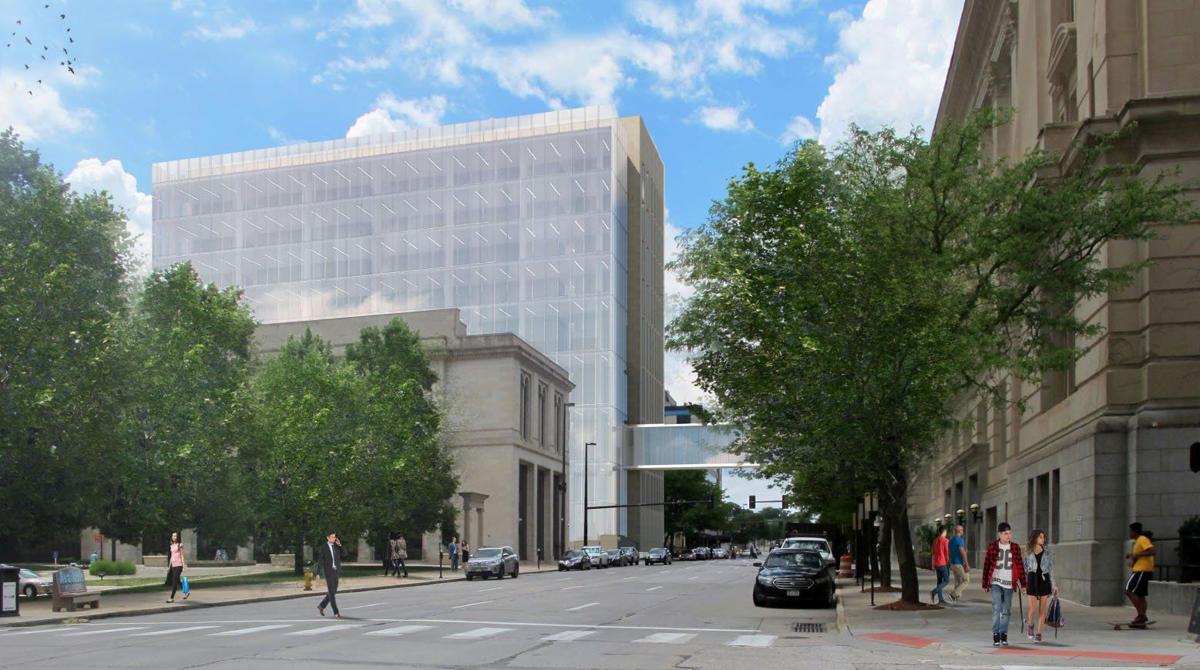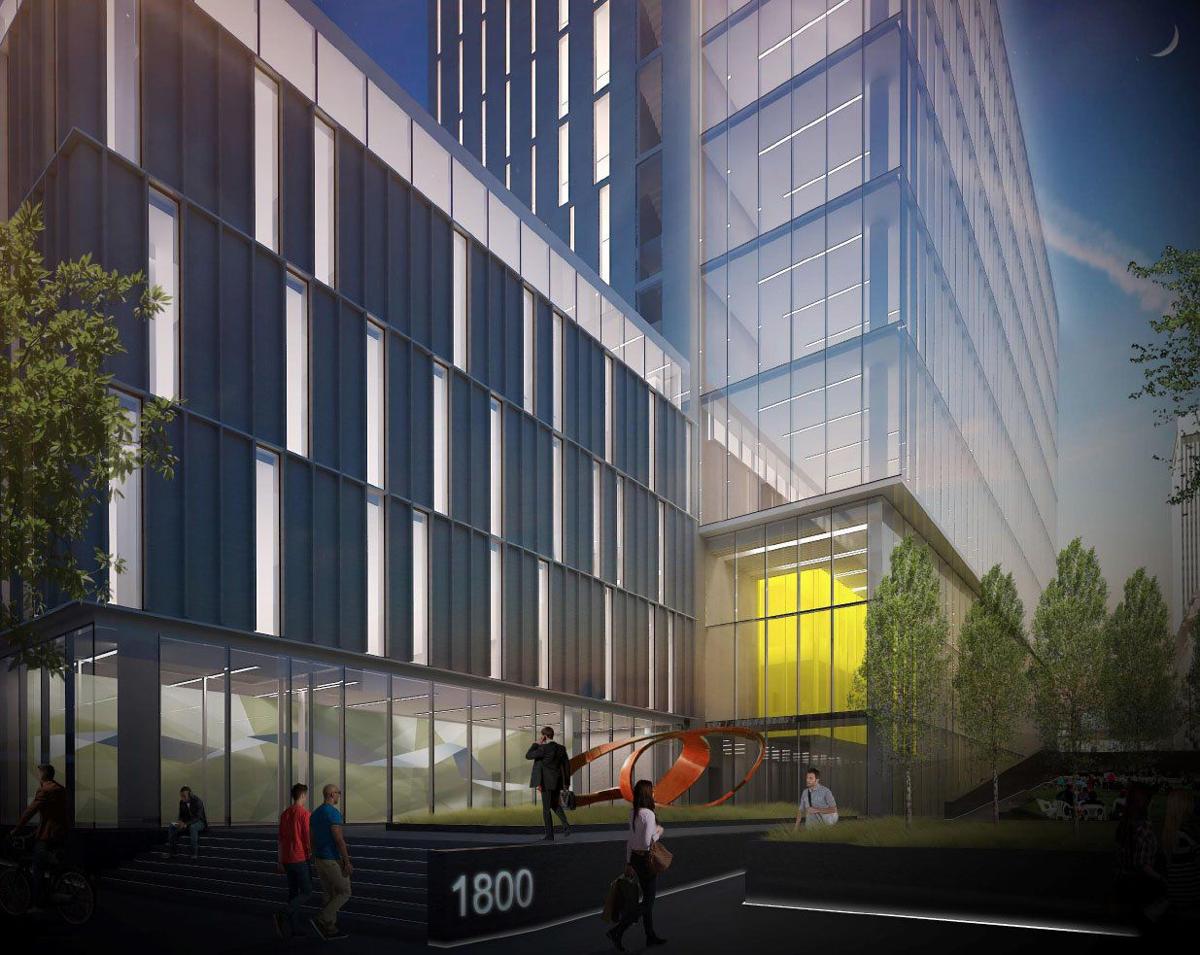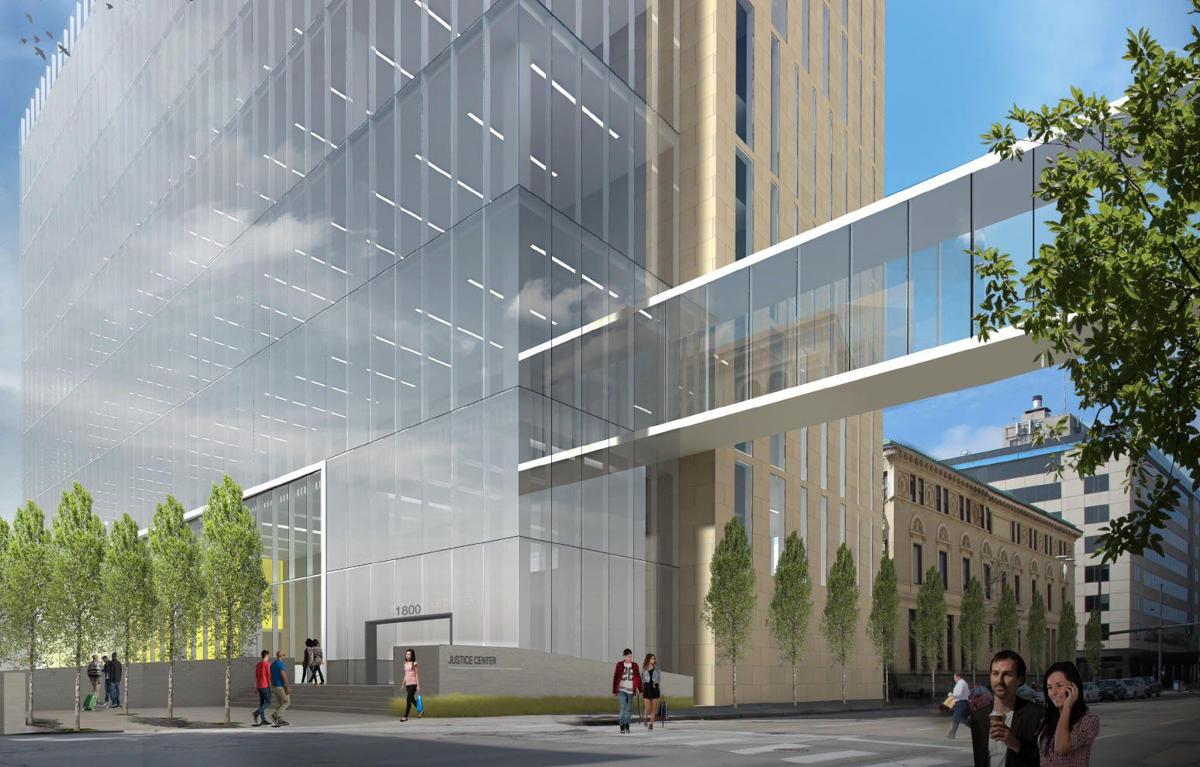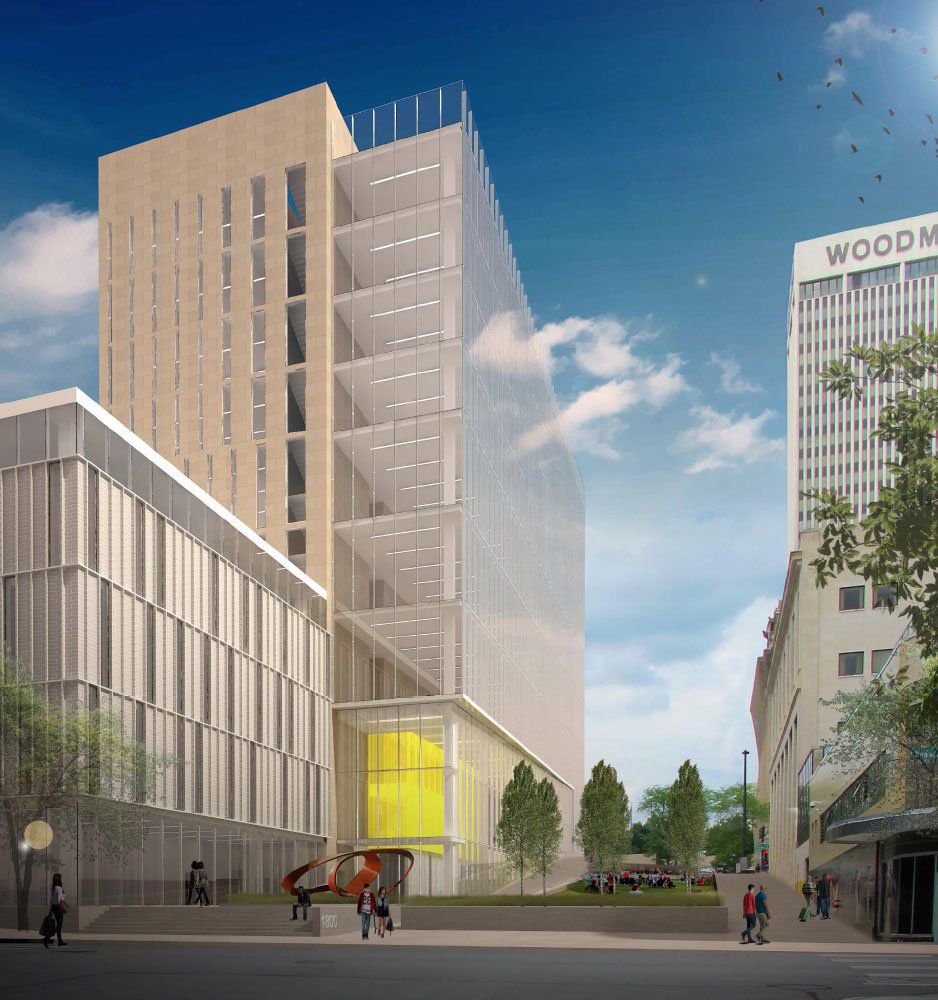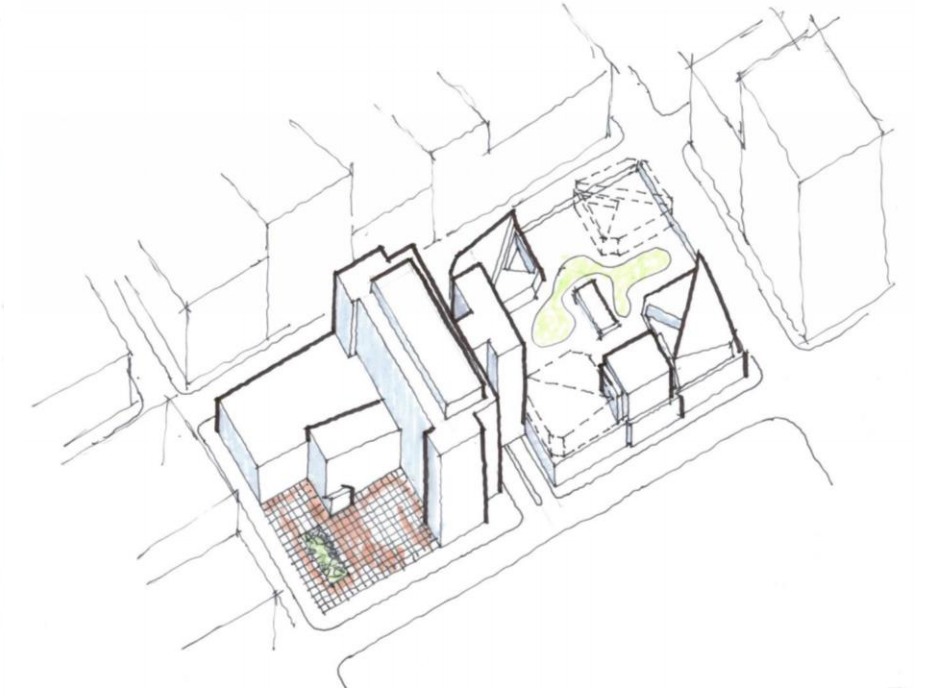Juvenile Justice? by Dawaune Lamont Hayes & Luis E. Jimenez
“I wish we would spend more time helping these young people instead of building jails or detention centers,” said Portia Cavitt, when asked what she knew about the Douglas County Board of Commissioners’ plan to build a juvenile justice center at 18th and Harney Streets.
Pastor Portia Cavitt
Cavitt, known by most as Pastor P, is reverend of Clair Memorial United Methodist Church at 5544 Ames Street. She has served in ministry for more than 20 years working with young people and communities of color. Cavitt said she first heard about the project after seeing news reports about eminent domain. She asks, “Why do we need a new building if we can work on these young people now?”
Cavitt’s questions emphasize a wave of concern from citizens who say a lack of transparency and public input in the County’s planning has brought the issue of juvenile justice to the fore.
The County proposal calls for the construction of two buildings and a parking garage. One 10-story building would house Douglas County Juvenile Court, juvenile and family services, and offices of the Douglas County Attorney and public defenders. The court is expecting a new juvenile judge and possibly two more on the way. Actions to implement the plan are currently underway, including the acquisition of land at the determined location.
Clare Duda, member of the Douglas County Board and Omaha-Douglas Public Building Commission, said the need for additional space is real. “We are out of room, and so we have no choice but to address this, and we have to address this now,” he said.
A second structure would serve as a youth detention center with 48 beds and future holding capacity for 64 young people. That is reduced from the capacity of 96 beds and 144 holding capacity at the current Douglas County Youth Center (DCYC), 1301 S 41st Street. The 90,000 square foot campus has maintained an average population of 81 young people between Jan. 1 to Aug. 31, 2018.
Board of County Commissioners Douglas County Nebraska meeting August 14, 2018. Video starts at 4:24:30, direct quote at 4:26:16.
Commissioner Chris Rodgers, County Board chair and head of their Child and Youth Services committee, says he is in favor of a smaller facility. “It will force the system to change and it’s been a degree that we’ve been going. If you build a building for a hundred people, you’ll fill it with a hundred people. You build it for 40, you’ll find a way,” he says. Cavitt wonders, “Does that mean they are going to do restorative justice and mean that there won't be more young people in the system?”
Proponents of the complex say the new center would concentrate juvenile justice services into a “one-stop model” and is estimated to cost taxpayers $120 million in bonds. The Douglas County Clerk’s website explains, “The recent average assessed value of a residential property in Douglas County was $159,840. At this assessed value, the increase in property taxes would be $47.95 a year, or $3.99 per month.” This complex would be the largest building in the history of Douglas County government. The county budgeted $1.3 million for juvenile related services outside of DCYC.
R to L: Commissioners Mike Boyle, Jim Cavanaugh, Chris Rodgers, PJ Morgan, Marc Kraft, Mary Ann Borgeson, and Clare Duda – commissioners.douglascounty-ne.gov
There is no oversight body for the Douglas County Board of Commissioners. They do not report to any other government level body, as stipulated in the constitution of Nebraska.
The swift pace, price tag, and lack of public engagement has citizens concerned. “What bothers me is that it seems like it’s a done deal and nobody even asked if Douglas County taxpayers can afford [the tax increase]. What are the alternatives? Why is this already a done deal with all these contractors?” said a minister who works with youth in the juvenile justice system. The companies tapped to build and manage construction of the center are HDR, Kiewit, and Burlington Capital.
How did this juvenile justice center plan come to be?
Reports by the Omaha World-Herald show the Public Building Commission had originally expressed interest in a downtown location in August 2017. The Commission then conferred with Omaha-based architecture firm, DLR Group, and consulting firm, Chinn Planning, to complete a study called the of the Juvenile Justice System and Court Space Needs Assessment.
The final report was released in January 2018. A few key findings state:
There is no overall vision and mission statement for the juvenile justice system in Douglas County.
The current detention center does not reflect best practice in modern secure youth residential facility design. The facility does not reflect a trauma-informed care environment.
Juvenile courtrooms and all areas of the sixth floor of the courthouse are inadequate. They are crowded, non-trauma responsive, and do not reflect best practice for court facilities.
These are select points; we recommend viewing the full report.
The January report also briefly outlines two site options for the new juvenile justice center, a “open/large site” and a “restricted/small site.” The open concept details a mini school campus environment with comprehensive services including recreation, education, and health and a single story juvenile detention facility. This is noted as best practice.
The restricted concept describes a two-story detention center and notes that a downtown location would be an expensive construction solution too close to adult justice and detention facilities. It is also contrary to national best practices which recommend low-rise buildings with natural light and access to outdoor recreation and nature.
Despite the report’s clear recommendations, the Building Commission and County Board chose an area downtown near 18th and Harney, two blocks from the adult county jail. News of acquisitions became public in April with the County’s purchase of the Omaha Housing Authority building and parking lot.
In May, the County Board attempted to buy property at 420 S. 18th Street, owned by architect Bob Perrin. He refused the offer and stated his plans to renovate the structure for future mixed-use development in the growing Flatiron District. Regardless of Perrin’s intentions, the County voted on July 10, to use eminent domain and seize the property for demolition, a familiar scenario for the architect.
The University of Nebraska Board of Regents used eminent domain authority to acquire land from Perrin south of Leavenworth Street for University of Nebraska Medical Center expansion in 2016. After a two-year legal battle, the university paid Perrin $1.975 million for his land.
After voting to take Perrin’s building, a nonprofit corporation called Douglas County Unified Justice Center Corporation was identified to oversee the justice center project as an instrumentality of the County Board and Building Commission. An “ancillary services agreement” was approved by County Board members, officially assigning management responsibilities to the corporation. Articles of Incorporation for the nonprofit were filed on Nov. 8, 2017 by a lawyer from Burlington Capital.
The corporation’s board of directors are Douglas County Board members Mary Ann Borgeson and PJ Morgan; Omaha City Council President Ben Gray; Douglas County Attorney Don Kleine; John Christensen, chair of the Public Building Commission; and David Levy, a member of the Omaha Housing Authority board.
“The corporation would function like private entities that the University of Nebraska used to develop the University of Nebraska Medical Center’s Fred and Pamela Buffett Cancer Center and the University of Nebraska at Omaha’s Baxter Arena,” officials told the World-Herald.
Operation Youth Success produced a called the Douglas County Juvenile Services Comprehensive Community Plan on July 1. This report outlines priority areas and coordinating strategies to eliminate youth involvement in the justice system while maintaining public safety. The community plan also emphasizes that funding should be directed to enhancing prevention efforts rather than intervention efforts, with participants of the study suggesting many intervention efforts are “too little, too late.”
Currently, the DCYC website lists two programs: Release Ministries, a faith-based mentorship and group home program, and H.O.M.E., an iteration of house arrest. Commissioners Rodgers and Borgeson have generally referenced plans to employ additional “at-home” programs in order to reduce the number of children in juvenile detention. Those programs, the facilitators, and potential outcomes have yet to be explicitly outlined for the public.
Proposed site in proximity of County Corrections
The plan has not been wholly supported by the County Board as Commissioner Jim Cavanaugh has been a vocal opponent from the beginning. He believes in and has proposed a campus-like alternative that refurbishes the 1950s-constructed DCYC would be more economical and provide a better experience for young people. “A school-like place is much better than a cell block only blocks away from the adult county jail,” Cavanaugh said.
When Brad Alexander, director of DCYC, was asked by Cavanaugh about his preference for future facilities at a public Administrative Services Committee meeting on July 25, he said, “I have no idea what’s being proposed to be honest with you.” “That’s unfortunate,” replied Cavanaugh.
Perrin’s Building at 420 S. 18th Street
Commissioner Mike Boyle, an original supporter of the downtown plan, voiced opposition during the County Board meeting on Aug. 28, stating, “I have met with people and I’ve listened. We need to move. The juvenile detention center should not be in downtown. It doesn’t do the things we need to do. I’m concerned about the children, which all of us are at some point. We don’t need to take Mr. Perrin’s building.”
On September 10, Brian Smith, local activist and organizer of Omaha Public Meetings, held a public forum co-hosted by Black Men United to discuss the juvenile justice center. The meeting was attended by Commissioner Boyle. After hearing about the reduced capacity, a woman asked, “Where will the overflow go?”
In response, Tyler Wilson, a state certified correctional officer and vocal opponent said juveniles cannot be within sight or sound of adult offenders, therefore young people must be placed in separate detention centers. The nearest qualified facilities outside Douglas County are in Lincoln and Grand Island, Nebraska as well as Council Bluffs, Iowa. Young men are currently sent out of county as far away as Canyon State Academy in Arizona, which claims to employ a “least-restrictive program model and normalized high school environment.”
Andrea Fordd, a criminal justice reform advocate, shared her experience working with young people. “I took on a child that was in trouble with the justice system myself, for somebody else. I had the luxury of having her parents paying for our home program.” Fordd explained the cost of weekly drug counseling, probation meetings, monthly psychiatry visits, and medications averaged over $400 a month. “If it were my child...and if I couldn’t afford it, my child is going to jail,” she said. Only half of youth placed on home detention successfully complete the program.
Community members have also expressed outrage with disproportionate minority contact (DMC). Minority youth are overrepresented in secure detention—11% of Douglas County population is African American but 55% of youth in detention are African American.
“We’re talking about processes of mass incarceration in a white supremacist nation and these policies are developed by unknowing and blissfully unaware white people!” exclaimed Doug Paterson, an older white man and former educator at the public meeting.
Ultimately, people want to see programs and outcomes. “We’re talking about this $120 million (total) and $37 million (for juvenile detention), how much money are we going to spend on these kids to try and keep them out of trouble?” asks Dominic Fordd, Andrea’s husband, and justice reform advocate who was once incarcerated.
Commissioner Cavanaugh responding to Mariah Person at September 24 Administrative Services Committee Meeting discussing a Juvenile Justice Center alternative
Young people like Mariah Person posed a similar question at an Administrative Services Committee meeting on September 24. Person asked, “When are these amenities and programs going to be written out in a proposal so that people can at least review these thoughts and actually solidify if they’re being pursued to an official point?”
Commissioner Jim Cavanaugh told her the committee has been looking at best practices across the country and thinks that it ought to be a robust community discussion but did not provide a timeline or list of programs. Current alternatives to detention are underutilized or not very effective as noted in the DLR/Chinn Report.
Overall, the opaque process and lack of public engagement from public officials has rubbed a lot of citizens the wrong way, especially Smith. “We’ve only been talking about buildings at this point, this has not been [tied] to any policies, has not been tied to any programs, it has not been tied to anything in specific that will tell us we are going to treat kids better, we are going to reduce the amount of kids in detention, and we are going to have better outcomes because of this.”
Heeding public concern, on September 25 Commissioner Boyle submitted three resolutions to rescind use of eminent domain, pause plans for the downtown juvenile center in favor of more public engagement, and consider renovation of the present youth detention facilities.
Mr. Cavanaugh supported Boyle, “Let’s do this right, not quick. Let’s do this with better, smarter, cheaper alternatives, and let’s put it on the ballot and vote.” The resolutions failed to pass after Commissioners Borgeson, Duda, Morgan, Rodgers, and Marc Kraft voted against them.
The County Board, Building Commission, and the non-profit corporation have a path to move forward. Currently, eminent domain has been temporarily halted by district court in response to a lawsuit filed by Bob Perrin. If court appointed appraisers set a price and the county and the judge sign off on it, the county could submit a check for that price, receive the title and take possession of the property. After that, the property would be demolished, making way for the new buildings and parking garage.
In the end, Pastor Portia Cavitt hopes the conversation comes down to people, “What are we doing to restore life? The justice system should be a system that helps people instill life, not lock it away.”
How do you think the County should proceed?
Click here to see official statements and records
You can find your commissioner’s email at https://commissioners.douglascounty-ne.gov/ or give them a call at 402-444-0725 or, if you are able, you can voice your opinion during the public comment portion of Commissioner meetings on Tuesdays starting at 9 a.m.
October 3 Update: The Omaha Landmarks Heritage Preservation Committee voted unanimously to recommend approval for landmark status of Perrin’s building. This vote is only a recommendation and does not mean the building won’t be torn down, but Perrin hopes it will encourage the commissioner’s to change their mind. The building was constructed in 1920 and served as an auto dealership then as a testing site for Army Corps of Engineers from 1948 to 1967.
October 30 Update: Mayor Jean Stothert held her District 2 town hall at The Venue at Highlander (2120 N. 30th Street) Monday, Oct 29. During the meeting, Luis Jimenez inquired as to if Mayor Stothert had spoken with Commissioner James Cavanaugh about the juvenile justice center. The Mayor said she did not discuss the project during their last encounter but recently spoke to other county commissioners.
Omaha Mayor Jean Stothert presented her town hall at The Venue at Highlander. She gave her annual report out then took questions from citizens. Here her direct quotes about the Juvenile Justice Center here.
“As of late last week, I talked to Clare Duda and, um, Marc Kraft. They came in and they came and walked me through the whole issue with the juvenile justice center. I’ve talked to councilman Gray about it, I’ve talked to councilman Amy Melton about it, who was also on the Building Commission,” said the mayor, “Right now I still don’t have enough information to answer any questions about why it was designed the way it was. But I will tell you this, definitely there is a need for a new juvenile court system.”
The mayor described overcrowding on the sixth floor of the current Douglas County courthouse as reasoning for a new space.
“I don’t think anything final, unless Ben Gray you can tell me different, has been decided,” said Stothert. “It is hard for me to comment on something I had just been briefed for the first time by county board members last week. No plans have been finalized yet.”
“As you know, the youth center is just basically a holding area until they go to trial,” she said. Stothert admitted she visited the Douglas County Youth Center for the first time two weeks ago.
The mayor then asked District 2 councilman Ben Gray, who is on the board of the Douglas County Unified Justice Center Corporation overseeing financing and construction of the center, to comment.
“The juvenile justice center the cost of it was $120 million that was a guess from some of the developers that were starting to look at it but now some of the dollars are starting to go down. “But I’m supportive of the juvenile justice center and the detention center being housed in same place.”
Minneapolis and Pittsburgh were cited as examples where co-located facilities supposedly reduced the number of individuals in custody by “a number of percentage points,” according to Councilman Gray.
Jimenez recalled data showing detainment had decreased in the current DCYC facility. “Well, we can make it work better,” Gray retorted.
Mayor Stothert made clear the juvenile justice center is not the city’s responsibility. “This is not a city project and the city has not been involved in this,” she said.



